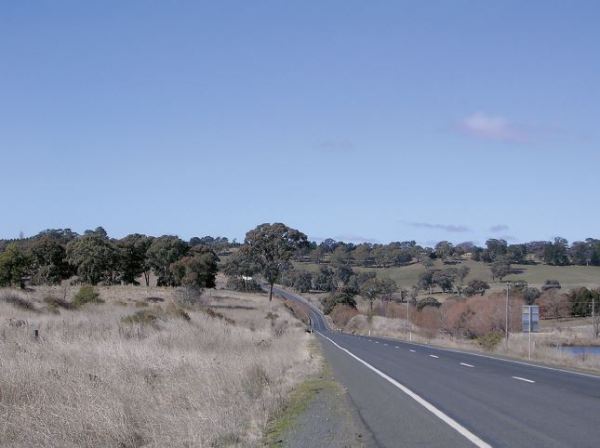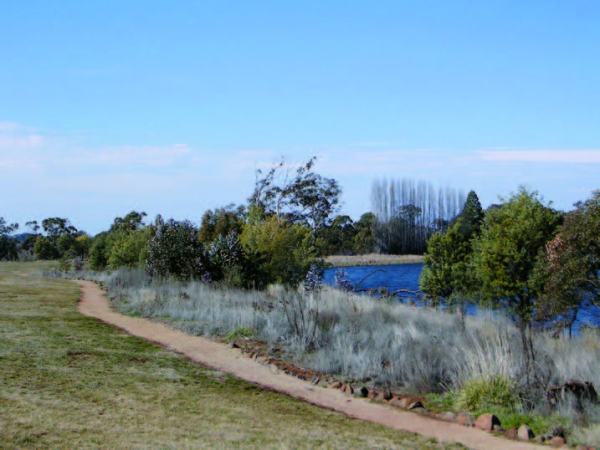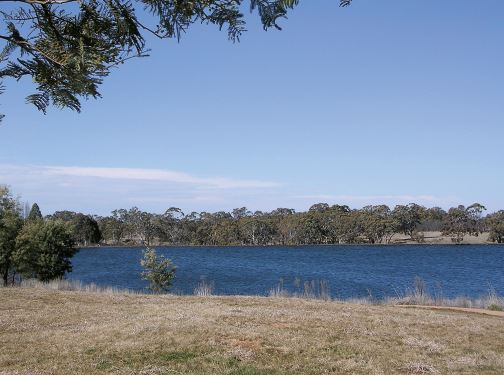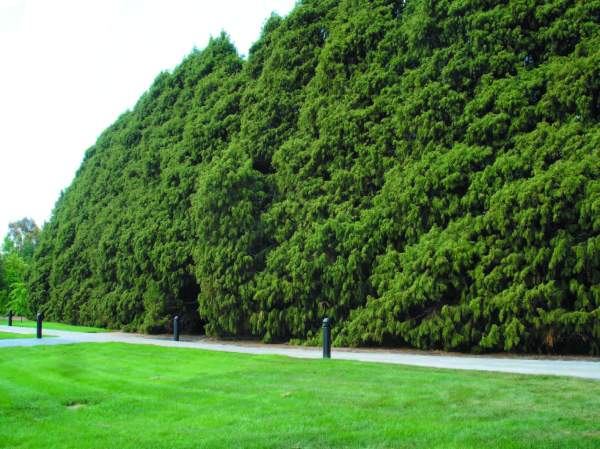Manna Gum Location: Northern side of drain Elephant Park, Woodward Street, Orange Tree Species: Manna Gum (Eucalyptus viminalis) Physical Description: Large trunked tree with a semi domed form. DBH - 544cm Statement of Significance This Manna Gum has significance for is age and height. It provides shade, habitat and food for a variety of birds,... Continue Reading →
Significant Trees: Central Orange
Apple Box Location - East side of T intersection on corner of Racecource Road and Woodward Street. Near Blackmans Swamp Creek and Pilcher Park. Tree Species Apple Box (Eucalyptus bridgesiana) DBH - 536cm Statement of Significance This Apple Box tree is significance for its value to provide habitat, food, nesting and hollows for birds, mammals,... Continue Reading →
Significant Trees: Central Orange
Binya Pine located rear yard of Orange Fire Station Location Rear yard of Orange Fire Station, part of the Precinct of Central Orange. Tree Species Bunya Pine (Araucaria bidwillii) Physical Description Large trunked tree with a semi domed form. Tree is a healthy specimen with no signs of deterioration. Statement of Significance This Bunya Pine... Continue Reading →
Significant Trees: Croagh Patrick
Pine and Cedars at Croagh Patrick Location Park Street, Bowen. Tree Species Pine (Pinus sp) Cedar (Cedrus sp.) Physical Description Condition of mature trees are to a high standard with dense foliage and typical branch structure. No evidence of pruning Statement of Significance Many of the avenue plantings have historical significance because they are believed... Continue Reading →
Endsleigh Avenue Vista
Endsleigh House located on the bend of Endsleigh Avenue Location Endsleigh Avenue. Statement of Significance Endsleigh Avenue follows the Main Western Railway and has an uncharacteristic bend in the road, close to the Franklin Road rail bridge. The road bends to the West and accommodates Endsleigh House which terminates the vista. The tall exotic plantings... Continue Reading →
View from The Escort Way
View to Mount Canobolas Location View from The Escort Way at the Local Government Area (LGA) boundary. Statement of Significance View from The Escort Way at the entry point to the City reveals an unimpeded view of Mount Canobolas to the South. The view is significant in that Mount Canobolas is an iconic landform that... Continue Reading →
The Escort Way
The Escort Way Location The Escort Way, West of Orange Statement of Significance This area extends from suburban fringes of Orange to the Local Government Area boundary. The community consultation process identified this landscape as significant for the stands of remnant Box vegetation. Eucalyptus albens (White Box) and Eucalyptus melliodora (Yellow Box) are common along... Continue Reading →
Significant Trees: Burrendong Way (March)
Pinus radiata (left) and a Eucalyptus viminalis (right) Location Burrendong Way (March, North of Orange). Tree Species Radiata Pine (Pinus radiata) Physical Description The buildings of March are dwarfed by a mature, sparse canopied Pinus radiata and a mature Eucalyptus viminalis which is located adjacent to the boundary fence of the Church. The Pines and... Continue Reading →
View Burrendong Way
Elevated view towards Orange from Burrendong Way Location View towards Orange from Burrendong Way. Statement of Significance The ridgeline behind Orange containing The Pinnacle and Mount Canobolas form the backdrop to the city and a landmark for orientation. This view is significant with respect to orientation through the rural lands towards the city, as the... Continue Reading →
Burrendong Way (March)
Large, mature Pine trees visually define the village of March within the landscape Location Burrendong Way (March, North of Orange) Statement of Significance The historic hamlet of March consists of a scattering of buildings along one side of Burrendong Way. A stone wall on the road frontage of 590 Burrendong Way signals the approach to... Continue Reading →
Towac Pinnacle and Picnic Area
The rocky summit of the Towac Pinnacle in the foreground, with views over cultivated agricultural land Location Pinnacle Road, approximately 12 km South West from Orange. Statement of Significance The Towac Pinnacle is a significant geological formation. The Towac Pinnacle Picnic Area is a place of historic and aesthetic significance and is a Schedule 8... Continue Reading →
Significant Trees: Campbell’s Corner
Cypress, Cedars, Crab Apple and Oaks of Campbell’s Corner, Pinnacle Road. Location Campbell’s Corner, Pinnacle Road, approximately 8 km south west of Orange. Tree Species Cypress (Chamaecyparis sp.) Cedars (Cedrus sp.) Crab Apples (Prunus sp.) Oaks (Quercus sp.) Physical Description The dense foliage of the many Conifer species frame views into the park and provides... Continue Reading →
Campbell’s Corner
Location Campbell’s Corner, Pinnacle Road, approximately 8 km South West of Orange. Statement of Significance Campbell’s Corner is a small memorial park located along a road deviation on Pinnacle Road. The reserve has historical and landscape significance, both as a memorial and flora park. The flora park was developed by Victor Campbell, a landscape architect,... Continue Reading →
Significant Trees: Gosling Creek System
The broad canopy of Cedar (left), contrasts to the narrow upright form of the Giant Sequoia (right). Location Gosling Creek Reserve. Pinnacle Road (approximately 9 km west of Orange). Tree Species Giant Sequoia (Sequoiadendron giganteum) Cedar (Cedrus sp. ) Physical Description Trees are prominent as they are situated in a area of a majority of... Continue Reading →
Objects and Elements: Gosling Creek System (B)
Gosling Creek Reserve: Pedestrian/Cycle Way One of the major recreational features of the reserve is the pedestrian and cycle ways that have been developed around Gosling Creek Reservoir. The major pathway will link into a regional pathway currently under development. Scar Tree Cadia Road and Forest Road intersection. Located opposite Gosling Creek, this scar tree... Continue Reading →
Gosling Creek System (A)
Location Gosling Creek (between Spring Creek Reservoir and Cadia Road). Statement of Significance The watercourse of this section of Gosling Creek has significance attached to its history; the engineering works associated with Spring Creek and Gosling Creek Reservoirs; the changing environment of its reserves; and as a recreational space. Gosling Creek Reservoir was opened in... Continue Reading →
Significant Trees: Lake Canobolas
Location Pinnacle Road (approximately 9 km west of Orange). Tree Species Radiata Pine (Pinus radiata) Cedar (Cedrus sp.) Physical Description The Cedars are spectacular trees easily recognisable with their conical form and bright yellow/green foliage. The broad canopies of the Cedars provide shade and visual amenity to visitors of the dam. The mature Radiata Pines... Continue Reading →
Lake Canobolas
Lake Canobolas, looking toward the dam walls and showing the grassed foreshore areas Location Pinnacle Road (approximately 9 km West of Orange) Statement of Significance Lake Canobolas is a man-made body of water that was originally formed when Meadow Creek was dammed in 1918 to provide water for the expanding township of Orange. In the... Continue Reading →
Significant Trees: TAFE Driveway
Driveway of TAFE Rural Studies Annexe, Forest Road. Location: Driveway of TAFE Rural Studies Annexe, Forest Road. Tree Species: Cypress (Cupressus sp.) Physical Description: Large specimens at entry of driveway, this particular large specimen at entry of the TAFE driveway. Statement of Significance This mass planting of Cypress form a significant aesthetic feature within the TAFE site. The... Continue Reading →
Forest Road West
The now disused drive-in theatre, viewed from Forest Road Location: Western side of Forest Road (between Sharp Road and Cadia Road) Statement of Significance Along the Western side of Forest Road is a grouping of fairly disparate elements that together form a distinctive rural-urban fringe landscape. These are: the extensive native plantings of the TAFE Driveway;... Continue Reading →
Residential Trees: Racecourse Road
Location No. 2 Racecourse Road. Tree Species Magnolia (Magnolia sp.) Physical Description A Magnolia located in the front yard of the residence, a species regarded highly for their ornamental flowers. This particular species is a healthy specimen with glossy green leaves and rounded habit. Residential Tree Statements This Magnolia has an attractive ornamental flower that... Continue Reading →
Towac Park Racecourse
Location Racecourse Road, approximately 3 km South West of the Orange CBD. Statement of Significance Towac Park Racecourse was developed in 1870 and a grandstand was built six years later. Fire destroyed the timber Members Stand in 1973. The Timber Grandstand, Pavilion and entry avenue are listed as a Schedule 8 Heritage Items of Local... Continue Reading →
Significant Trees: Spring Hill
Location Left side of Millthorpe Road, south of Orange. Tree Species Hawthorn (Crataegus monogyna) Physical Description A dense compact grouping of Hawthorn hedges are located parallel to Millthorpe Road. Colourful foliage is produced during Autumn. Die back is occurring on many of the hedges, which will need to be removed. Statement of Significance This stand... Continue Reading →
View of Bluestone Church
Location Methodist Church, Carcoar Road. Statement of Significance This view is considered significant because of the positioning of the church on the hill and its relationship with remnant Eucalypt vegetation. The foreground to the view from Forest Road is a flat, open paddock with minimal diversity and this draws the eye to the church in... Continue Reading →
Spring Hill
Streetscape of Spring Hill showing historic buildings and accompanying interpretive signage Location Forest Road, South of Orange. Statement of Significance Spring Hill village sits within a plateau landscape on the Southern border of the Orange Local Government Area. The laying of the railway from Bathurst to Orange is believed to have formed much of the... Continue Reading →
Huntley Stone Walls
Location “Cragieburn”, Huntley Road. Statement of Significance On the edge of a slight rise are the largely intact remnants of a dry stone holding pen or walled garden. Stone walls seem to have been relatively uncommon in the district, with post-and-rail forming the usual approach to fencing prior to wire fencing. The community consultation process... Continue Reading →
Views of Native Vegetation
Location Native Vegetation - various locations, yet predominantly in the Eastern areas of the Local Government Area. Statement of Significance Patches of remnant Box vegetation occur sporadically throughout the Local Government Area (LGA) and are mostly contained to road reserves and isolated hillsides. Views of these remnants contribute to the way in which Orange is... Continue Reading →
Shadforth
Exotic species mark the village’s location within the rural landscape Location Mitchell Highway, a place within the Precinct of Frederick’s Valley. Statement of Significance Shadforth has historic significance as it was considered to be a contender as a location for the main town in the district. However, the limitations of its topography meant that the... Continue Reading →
Lucknow
Location Mitchell Highway, South East of Orange, a place within the Precinct of Frederick’s Valley. Statement of Significance The landscape of Lucknow has significance for its historic link to the gold mining operations that were important for the early prosperity of Orange. Several periods of intense mining have shaped the landscape of Lucknow since the... Continue Reading →
Chinaman’s Bend Cemetery
Location Mitchell Highway, approximately 4 km South East of the Orange CBD forms a place with the Precinct of Frederick’s Valley. Statement of Significance Chinaman’s Bend Cemetery is listed on the Register of the National Estate as both an historic and geological site of significance. The Cemetery is a Schedule 8 Heritage Item of State... Continue Reading →
Significant Trees: Frederick’s Valley
Location Highland Heritage Estate and Winery, Mitchell Highway. Tree Species Oak trees (Quercus sp.) Physical Description Two Oaks located at either side of the entry, provide a feature entry to the estate. The trees are healthy specimens with densely leafed branches, which provide good shade and visual amenity. Statement of Significance The Oak trees form... Continue Reading →
Precinct: Frederick’s Valley
Frederick’s Valley looking South from Lucknow towards Shadforth Location Frederick’s Valley - between Lucknow and Shadforth on the Bathurst Road (Mitchell Highway). Statement of Significance The valley between Shadforth and Chinaman’s Bend has a unique landscape and offers views along its length. The valley is narrow and elongated along the Summer Hill Creek with the... Continue Reading →
View from Phoenix Mine Road
Location Phoenix Mine Road. Statement of Significance Phoenix Mine Road offers a sequence of changing views as it traverses up slope from Lucknow. The road meanders to accommodate the level change and this results in a range of views being available. The road rises from the floor of Frederick’s Valley near Lucknow and elevated views... Continue Reading →
Frederick’s Valley
Location Frederick’s Valley is traversed by the Mitchell Highway between Chinaman’s Bend and Shadforth. Statement of Significance The landscape of Frederick’s Valley is characterised by evidence of Orange’s historical development since European settlement. The land has been cleared for agriculture and mining; the creek course diverted for mining; villages have been settled and roadways built.... Continue Reading →
Significant Trees: Gateway Park
Location Mitchell Highway, approximately 3 km south east of the Orange CBD. Tree Species Lombardy Poplar (Populus nigra cv. ‘Italica’) Physical Description A lineal planting of Poplars, adjacent to the Mitchell Highway exhibit a narrow conical habit. The trees provide a changing feature entry to Orange: with their deep green foliage in summer, turning yellow... Continue Reading →
View from Gateway Park
View of Mount Canobolas and The Pinnacle from Gateway Park Location View from Gateway Park, Bathurst Road (Mitchell Highway). Statement of Significance View of Mount Canobolas and The Pinnacle from Gateway Park, as seen through the avenue of Lombardy Poplars. This view signifies the arrival into Orange City Centre and can only be appreciated in... Continue Reading →
Gateway Park
Location Mitchell Highway, approximately 3 km South East of the Orange CBD. Statement of Significance The linear planting pattern of the Lombardy Poplars at Gateway Park forms a distinctive landscape feature of the approach to Orange from Bathurst. The Poplars have been planted in a line, parallel to the road from which a sequence of... Continue Reading →
Significant Trees: Orange Cemetery
Location Orange Cemetery. Lone Pine Avenue, Bowen. Tree Species Himalayan Cypress (Cupressus torulosa) Physical Description The two Cypresses exhibit a strong upright conical habit, which is broad spreading at the base. Statement of Significance These trees form a visually prominent feature of the cemetery landscape. The heritage listing for the cemetery notes that the mature... Continue Reading →
Orange Cemetery
An avenue planting of Eucalypts provides a backdrop for the grave sites in the foreground, with flowers adorning many of graves Location Lone Pine Avenue, Bowen. Statement of Significance Orange Cemetery was one of the early civic constructions at Orange. It was reserved and laid out in 1853 as a replacement for the cemetery at... Continue Reading →
Bathurst Road Memorial Avenue
Location Bathurst Road (between McLachlan Street and Redmond Place). Statement of Significance Memorial Avenue is a commemorative landscape and a distinctive feature of the approach to Orange from Bathurst. The original avenue planting of Cedrus deodara dates from 1923 when they were planted as a memorial to the Orange residents who had died fighting in... Continue Reading →
Suma Park Dam
Location Suma Park Dam, approximately 4 km East of Orange. Statement of Significance Suma Park Dam was commissioned in 1962 and since then has become a significant water feature within the landscape to the East of Orange. The dam has significance as an example of 1960s engineering as well as historic significance as it was... Continue Reading →
Significant Trees: Banjo Paterson Memorial Park
Location Banjo Paterson Memorial Park, Orphir Road, approximately 6 km north east of Orange. Tree Species Oak tree (Quercus sp.) Hawthorn (Crataegus monogyna) Physical Description Two mature Oak trees with a typical broad form and dense branch structure. The Hawthorn specimen trees are showing evidence of die back and lower branch formation due to stress.... Continue Reading →
Banjo Paterson Memorial Park
Anthony Chandler’s Bronze Bust of Banjo Paterson stands near the trees which stand as testimony to the prior presence of the homestead of Narrambla Location Ophir Road, approximately 6 km North East of Orange. Statement of Significance Banjo Paterson Memorial Park is a small historic site set within rural surroundings. The mainly open site includes... Continue Reading →
Waratah Oval
A row of planting separates the playing fields from the water Location Farrell Road, Bletchington. Statement of Significance Waratah Oval is located at the Northern suburban fringe, in an area that is currently under the process of being subdivided for residential development. The community consultation process identified the “wetland” area near Waratah Sports Complex as... Continue Reading →
Residential Trees: Clifton Grove
Location Clifton Grove Homestead, corner of Coolabah Drive and Banjo Paterson Way, Clifton Grove Estate. Tree Species Radiata Pine (Pinus radiata) Lombardy Poplar (Populus nigra cv. ‘Italica’) Physical Description Tree maturity has been reached and show no signs of decline. Trees show typical characteristics of form and growth. The trees are located adjacent to the... Continue Reading →
Clifton Grove
Location North East of Orange, located East of Ophir Road and North of Summer Hill Creek. Statement of Significance Clifton Grove is a rural residential subdivision which receives its name from the original homestead. Clifton Grove is significant as one of the first planned rural residential estates in NSW. The subdivision plan was given approval... Continue Reading →
Bel Air
Location Bounded by Molong Road, Forbes Road and Pine Ridge Drive. Statement of Significance This subdivision formed part of the regional growth centre strategy undertaken by the Bathurst Orange Development Corporation (BODC). The strategy was launched in 1975 and this subdivision was one of the early concepts of the strategy. However, the plan for this... Continue Reading →
Significant Trees: Greengate Park
Location Rawson display home, corner of Burrendong Way and Mitchell Highway. Tree Species Deodar Cedar (Cedrus deoda ra) Oak trees (Quercus sp. ) Physical Description The trees frame the entrance to Burrendong Way from the Mitchell Highway. The blue/grey foliage of the Deodar Cedar contrast with that of the Oak Trees. Statement of Significance The... Continue Reading →
Significant Trees: Duntryleague
Location Entry Avenue, Northern border of Orange High School and Duntryleague. Tree Species Sequoia (Sequoiadendron spp.) Physical Description These particular trees exhibit a typical growth of cylindrical upright forms with dense branch structure. The trees have still not reached full mature height. Statement of Significance The Sequoia have a significance as an uncommon tree in... Continue Reading →
Duntryleague
Location Orange Golf Club, Woodward Street, Orange Statement of Significance Duntryleague was built in 1876 as a stately home for James Dalton, a member of the prominent Orange family, the Daltons. Duntryleague indicates the wealth of some of the Irish people who settled in Orange. Duntryleague, along with the Park, Gates, Gatekeeper’s Lodge and Stables,... Continue Reading →
















































